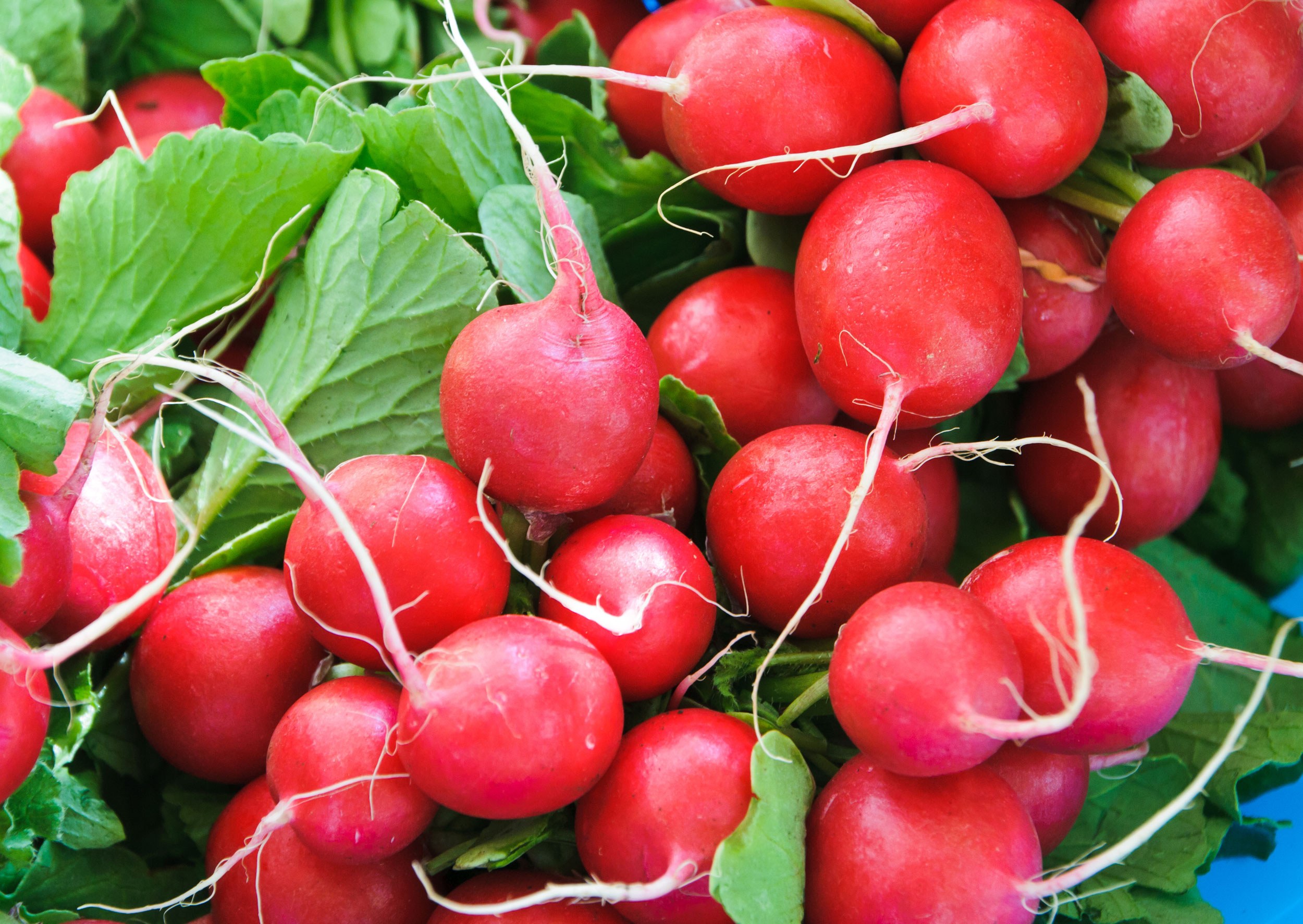Radish
Radishes, with their vibrant colors and crisp texture, are a staple in gardens and kitchens around the world. As a member of the Brassicaceae family, radishes share lineage with other well-known vegetables like broccoli and cabbage. Their distinct peppery bite adds zest to many dishes, and they're valued not just for their culinary uses but also for their nutritional benefits. Their global popularity means they've found their way into countless cuisines, from Asian to European.

More on Radish
About
The radish plant boasts a pungent edible root, with varieties ranging in color from the common red and white to purple, pink, and even black. Depending on the type, they can be small and round, or long and cylindrical. Above ground, radishes produce green leaves that are also edible, with a slightly bitter taste.
Radishes thrive in cool weather and well-drained soil. They are among the fastest vegetables to grow, with some varieties ready for harvest just a few weeks after planting. Their growth cycle, from seed to mature plant, is notably quick, making them a favorite among beginner gardeners and children's gardening projects.
Nutritionally, radishes are low in calories but rich in vitamins and minerals. They provide vitamin C, potassium, and other nutrients, and their natural compounds have been linked to various health benefits.
History
The radish is believed to have originated in Southeast Asia, with archaeological evidence pointing to its cultivation over 2,000 years ago. As ancient civilizations traded and migrated, radishes found their way to ancient Egypt, Rome, and Greece, where they were well-received and incorporated into local diets.
Throughout the ages, radishes have been celebrated in various cultures for their medicinal properties, with ancient texts lauding them for purported benefits, from aiding digestion to acting as a remedy for certain ailments.
Today, radishes hold cultural significance in various parts of the world. For example, in Asian cultures, particularly in Japan, the Daikon radish is not only a culinary staple but also plays a role in festivals and traditions.
Ways To Cook
The crisp and zesty nature of radishes offers a plethora of culinary applications:
- Raw: Often sliced or grated into salads for a crunchy, spicy element.
- Pickled: In various cuisines, radishes are pickled for an added depth of flavor.
- Roasted: When roasted, radishes become tender and their peppery bite mellows out.
- Stir-fries: Radishes can be diced and tossed into stir-fries with other vegetables and proteins.
- Soups: In certain cuisines, like Korean, radishes are integral to specific soup varieties.
- Dips & Spreads: Radishes can be blended into creamy dips or used as a base for zesty spreads.
- Garnish: Sliced thinly, radishes can be a decorative and flavorful garnish for various dishes.
While radishes are mostly consumed for their roots, their greens can also be used in salads, soups, or sautéed as a side dish. It's essential to ensure radishes are washed thoroughly to remove any residual soil or grit before consumption.
Radish Recipe Links
Alberta Radish Producers
Maple Park Farm
About this producerFoods from this producer:
-
- Vegetables
Green Bean
-
- Vegetables
- Roots and Tubers
Beet
-
- Vegetables
- Cabbage Family
Broccoli
-
- Vegetables
- Cabbage Family
Cabbage
-
- Vegetables
- Roots and Tubers
Carrots
-
- Vegetables
Celery
-
- Vegetables
- Leafy Greens
Kale
-
- Vegetables
- Onion Family/Aliums
Leek
-
- Vegetables
Lettuce
-
- Vegetables
Onion
-
- Vegetables
Pea
-
- Vegetables
Potatoes
-
- Vegetables
- Roots and Tubers
Radish
-
- Vegetables
Chard
-
- Vegetables
Zucchini
Riverbend Gardens
About this producerFoods from this producer:
-
- Vegetables
- Roots and Tubers
Beet
-
- Vegetables
Chard
-
- Vegetables
- Stalks, Stems, and Shoots
Asparagus
-
- Vegetables
Cucumber
-
- Vegetables
Zucchini
-
- Vegetables
- Cabbage Family
Cabbage
-
- Vegetables
- Leafy Greens
Kale
-
- Vegetables
- Cabbage Family
Broccoli
-
- Vegetables
Pumpkin
-
- Vegetables
- Roots and Tubers
Radish
-
- Vegetables
Onion
-
- Vegetables
Potatoes
-
- Vegetables
Corn
-
- Vegetables
- Stalks, Stems, and Shoots
Fennel Bulb
-
- Herbs & Spices & Flavourings
- Culinary Herb
Dill
-
- Vegetables
- Onion Family/Aliums
Leek
-
- Vegetables
- Roots and Tubers
Carrots
-
- Vegetables
Pea
-
- Vegetables
Green Bean
Homesteader Farms
About this producerFoods from this producer:
-
- Domesticated
- Feather
Egg (hen)
-
- Domesticated
- Fur
Beef
-
- Domesticated
- Fur
Lamb
-
Honey
-
- Vegetables
Potatoes
-
- Vegetables
- Roots and Tubers
Carrots
-
- Vegetables
- Roots and Tubers
Parsnip
-
- Vegetables
- Roots and Tubers
Beet
-
- Vegetables
Corn
-
- Vegetables
Cucumber
-
- Vegetables
Pumpkin
-
- Vegetables
Tomatoes
-
- Vegetables
Pea
-
- Vegetables
Green Bean
-
- Vegetables
Lettuce
-
- Vegetables
- Roots and Tubers
Radish
-
- Vegetables
Onion
-
- Herbs & Spices & Flavourings
- Culinary Herb
Dill
-
- Vegetables
- Cabbage Family
Cabbage
-
- Vegetables
- Cabbage Family
Broccoli
-
- Vegetables
Zucchini
-
- Fruit
Rhubarb
